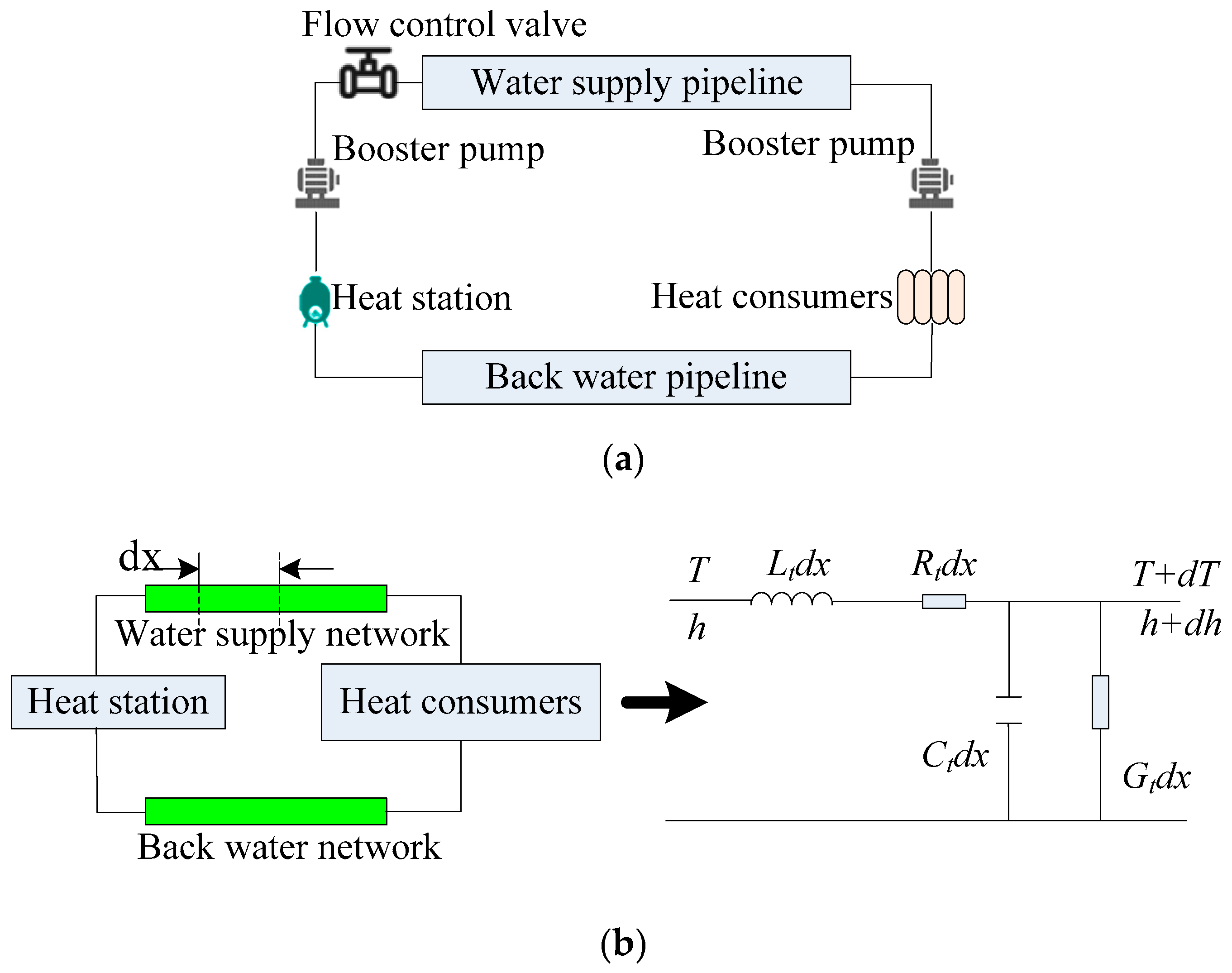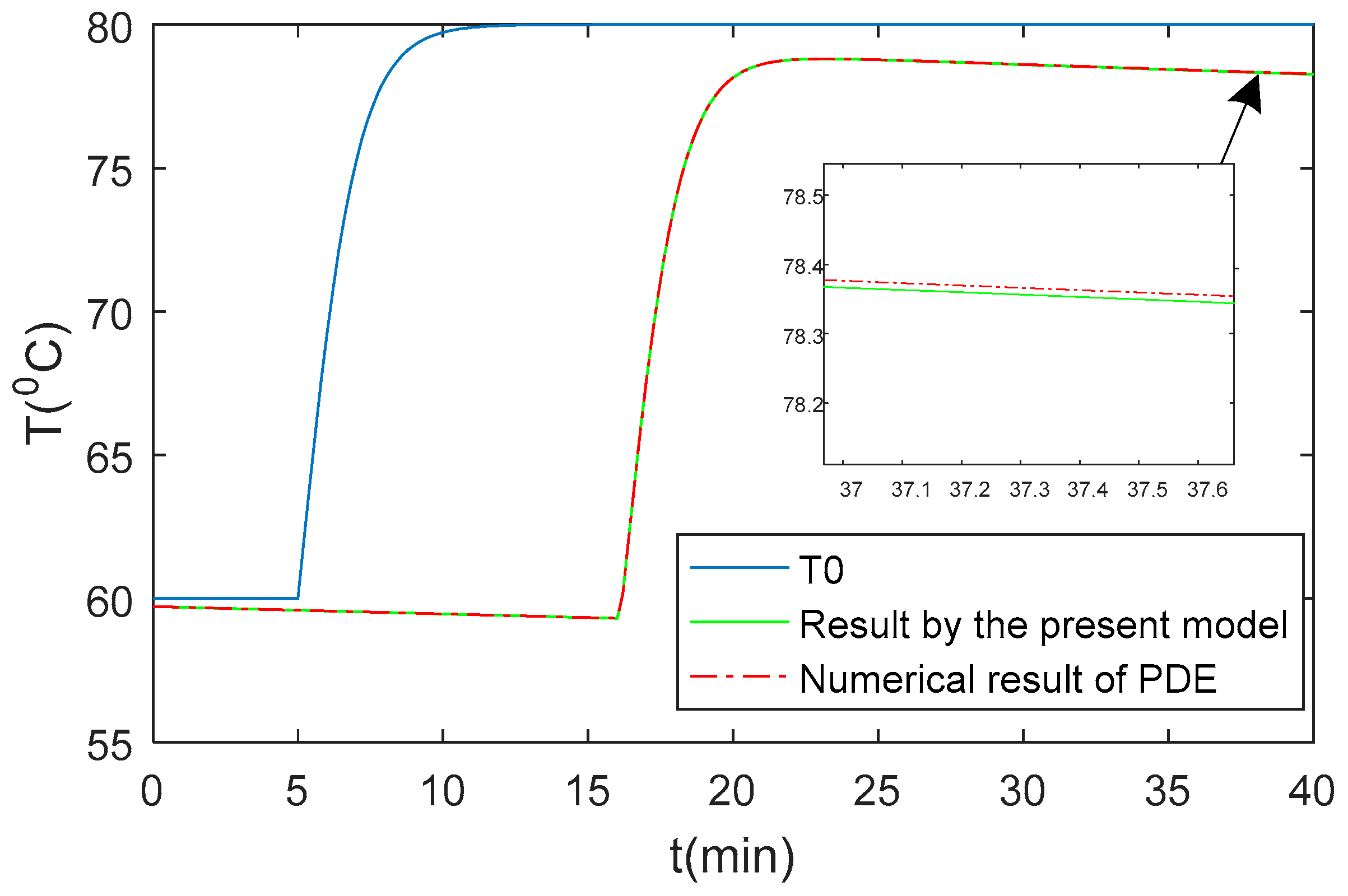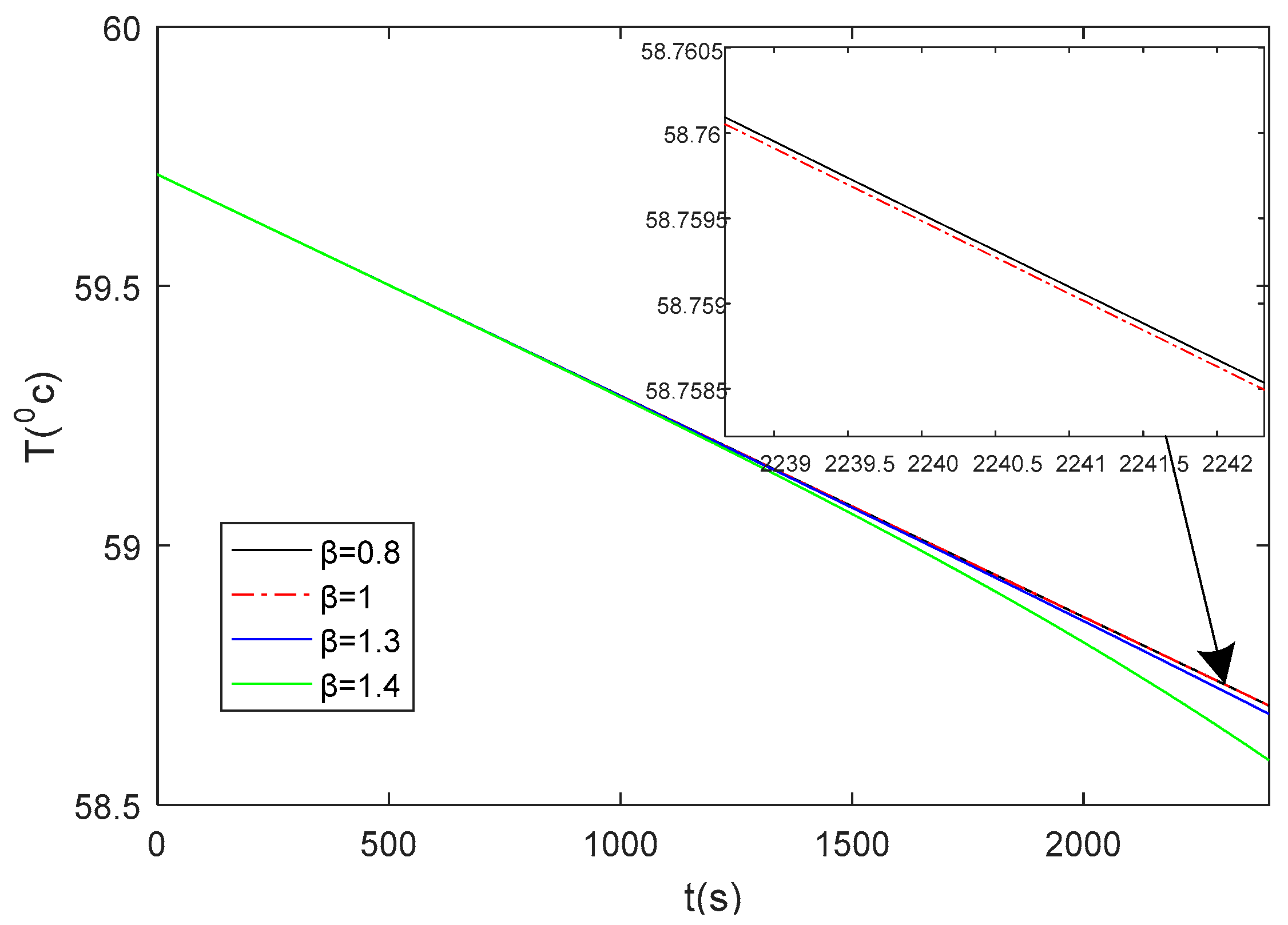Fractional Order Modeling of Thermal Circuits for an Integrated Energy System Based on Natural Transformation
Abstract
:1. Introduction
- (1)
- Compared with the electricity circuit model, the thermal circuit model is studied.
- (2)
- The fractional-order model of the thermal circuit is proposed.
- (3)
- The natural transform method is used to solve the thermal circuit model.
- (4)
- The influence of different fractional orders is analyzed.
2. Thermal Circuit Analysis of Heating Network
2.1. Classical Mathematical Modeling
2.2. Fractional-Order Mathematical Model
3. Solution Method for Solving Model Based on Natural Transformation
3.1. Natural Transformation
3.2. Model Solving
3.3. Comparison with Existing Thermal Circuit Models
4. Main Results and Discussion
4.1. Parameters
4.2. Analysis and Simulation Results
4.3. Discussion Based on the Results
5. Conclusions
- (1)
- Compared with the electric circuit model, the thermal circuit model has similar forms.
- (2)
- The proposed method reduces the computational complexity of the thermal circuit model. Compared with other models, the thermal circuit model in this paper can meet the accuracy requirements and the results can dynamically display the changes of pipeline temperature with time and position.
- (3)
- Fractional-order values have an effect on the results of heat transfer. The higher fractional-order causes a lower temperature. Different fractional-order values can be used to correspond to different conditions.
- (4)
- The model in this paper is the thermal circuit analysis theory, which is expected to contribute to the dynamic modeling of integrated energy system in the future. However, different fractional-order values correspond to different models under different conditions, which is the future research direction.
Author Contributions
Funding
Data Availability Statement
Acknowledgments
Conflicts of Interest
Nomenclature
| Abbreviations | |
| IES | integrated energy system |
| CHP | combined heat and power |
| PDE | partial differential equation |
| Parameters and Variables | |
| A\B\C | refers to constant coefficient of partial differential equation |
| c | refers to the specific heat capacity |
| Ct | refers to heat capacity |
| h | refers to heat power (W) |
| Gt | refers to thermal conductivity |
| l | refers to the length of pipeline |
| Lt | refers to thermal inductance |
| m | refers to the mass flow (kg·s−1) |
| Rt | refers to thermal resistance |
| S | refers to the cross-sectional area of the heating pipeline (m2) |
| T | refers to the temperature field (°C) |
| t | refers to time |
| x | refers to the position along the pipe |
| u\s | refer to the natural transform variables |
| ρ | refers to the density (kg·m−3) |
| λ | refers to the heat-loss factor of the pipeline (W·mK−1) |
| γ0 | refers to radial direction thermal diffusion coefficient (m2·s−1) |
| β | refers to fractional-order |
| refers to the gamma function | |
References
- Li, G.; Zhang, R.; Jiang, T.; Chen, H.; Bai, L.; Cui, H.; Li, X. Optimal dispatch strategy for integrated energy systems with CCHP and wind power. Appl. Energy 2016, 192, 408–419. [Google Scholar] [CrossRef]
- Huang, B.; Hu, M.; Chen, L.; Jin, G.; Liao, S.; Fu, C.; Wang, D.; Cao, K. A Novel Electro-Thermal Model of Lithium-Ion Batteries Using Power as the Input. Electrionics 2021, 10, 2753. [Google Scholar] [CrossRef]
- Yang, J.; Zhang, N.; Botterud, A.; Kang, C. On An Equivalent Representation of the Dynamics in District Heating Networks for Combined Electricity-Heat Operation. IEEE Trans. Power Syst. 2020, 35, 560–570. [Google Scholar] [CrossRef]
- Yang, J.; Zhang, N.; Kang, C. Generalized electric circuit analysis theory for multi-energy networks. Part one branch model. Autom. Electr. Power Syst. 2020, 44, 21–32. [Google Scholar] [CrossRef]
- Cheng, H.; Hu, X.; Wang, L.; Liu, Y.; Yu, Q. Review on Research of Regional Integrated Energy System Planning. Autom. Electr. Power Syst. 2019, 43, 2–13. [Google Scholar]
- Qu, L.; Ouyang, B.; Yuan, Z.; Zeng, R. Steady-State Power Flow Analysis of Cold-Thermal-Electric Integrated Energy System Based on Unified Power Flow Model. Energies 2019, 12, 4455. [Google Scholar] [CrossRef] [Green Version]
- Chen, Y.B.; Yao, Y.; Zhang, Y. A robust state estimation method based on SOCP for integrated electricity-heat system. IEEE Trans. Smart Grid 2021, 2, 810–820. [Google Scholar] [CrossRef]
- Dong, H.; Fang, Z.; Ibrahim, A.-W.; Cai, J. Optimized Operation of Integrated Energy Microgrid with Energy Storage Based on Short-Term Load Forecasting. Electronics 2022, 11, 22. [Google Scholar] [CrossRef]
- Li, Z.; Wu, W.; Shahidehpour, M.; Wang, J.; Zhang, B. Combined heat and power dispatch considering pipeline energy storage of district heating network. IEEE Trans. Sustain. Energy 2016, 7, 12–22. [Google Scholar] [CrossRef]
- Zhaoguang, P.; Qinglai, G.; Hongbin, S. Interactions of district electricity and heating systems considering time-scale characteristics based on quasi-steady multi-energy flow. Appl. Energy 2016, 167, 230–243. [Google Scholar]
- Li, X.; Li, W.; Zhang, R.; Jiang, T.; Chen, H.; Li, G. Collaborative scheduling and flexibility assessment of integrated electricity and district heating systems utilizing thermal inertia of district heating network and aggregated buildings. Appl. Energy 2020, 258, 114021. [Google Scholar] [CrossRef]
- Guelpa, E.; Toro, C.; Sciacovelli, A.; Melli, R.; Sciubba, E.; Verda, V. Optimal operation of large district heating networks through fast fluid-dynamic simulation. Energy 2016, 102, 586–595. [Google Scholar] [CrossRef]
- Yang, J.; Zhang, N.; Kang, C. Generalized electric circuit analysis theory for multi-energy networks: Part two network model. Autom. Electr. Power Syst. 2020, 44, 15–29. [Google Scholar] [CrossRef]
- Sarafraz, M.M.; Safaei, M.R.; Tian, Z.; Goodarzi, M.; Bandarra Filho, E.P.; Arjomandi, M. Thermal Assessment of Nano-Particulate Graphene-Water/Ethylene Glycol (WEG 60:40) Nano-Suspension in a Compact Heat Exchanger. Energies 2019, 12, 1929. [Google Scholar] [CrossRef] [Green Version]
- Stevanovic, V.D.; Zivkovic, B.; Prica, S.; Maslovaric, B.; Karamarkovic, V.; Trkulja, V. Prediction of thermal transients in district heating systems. Energy Convers. Manag. 2009, 50, 2167–2173. [Google Scholar] [CrossRef]
- Chen, Q.; Fu, R.H.; Xu, Y.C. Electrical circuit analogy for heat transfer analysis and optimization in heat exchanger networks. Appl. Energy 2015, 139, 81–92. [Google Scholar] [CrossRef]
- Manson, J.R.; Wallis, S.G. An accurate numerical algorithm for adventive transport. Commun. Numer. Methods Eng. 1995, 11, 1039–1045. [Google Scholar] [CrossRef]
- Zhou, S.-J.; Tian, M.-C.; Zhao, Y.-E.; Guo, M. Dynamic modeling of thermal conditions for hot-water district-heating networks. J. Hydrodyn. 2014, 26, 531–537. [Google Scholar] [CrossRef]
- Lin, C.; Wu, W.; Zhang, B.; Sun, Y. Decentralized solution for combined heat and power dispatch through benders decomposition. IEEE Trans. Sustain. Energy 2017, 8, 1361–1372. [Google Scholar] [CrossRef]
- Wu, C.; Gu, W.; Jiang, P.; Li, Z.; Cai, H.; Li, B. Combined economic dispatch considering the time-delay of a district heating network and multiregional indoor temperature control. IEEE Trans. Sustain. Energy 2017, 9, 118–127. [Google Scholar] [CrossRef]
- Wei, W.; Shi, Y.; Hou, K.; Guo, L.; Wang, L.; Jia, H.; Wu, J.; Tong, C. Coordinated Flexibility Scheduling for Urban Integrated Heat and Power Systems by Considering the Temperature Dynamics of Heating Network. Energies 2020, 13, 3273. [Google Scholar] [CrossRef]
- Zheng, J.F.; Zhou, Z.G.; Zhao, J.N.; Wang, J.D. Integrated heat and power dispatch truly utilizing thermal inertia of district heating network for wind power integration. Appl. Energy 2018, 211, 865–874. [Google Scholar] [CrossRef]
- Wu, X.; Zhang, Q.; Chen, C.; Li, Z.; Zhu, X.; Chen, Y.; Qiu, W.; Yang, L.; Lin, Z. Optimal Dispatching of Integrated Electricity and Heating System with Multiple Functional Areas Considering Heat Network Flow Regulation. Energies 2021, 14, 5525. [Google Scholar] [CrossRef]
- Chen, B.; Sun, H.; Wu, W.; Guo, Q.; Qiao, Z. Energy circuit theory of integrated energy system analysis (II): Hydraulic circuit and thermal circuit. Proc. CSEE 2020, 40, 2133–2142. [Google Scholar]
- Chertkov, M.; Novitsky, N.N. Thermal transients in district heating systems. Energy 2019, 184, 22–33. [Google Scholar] [CrossRef] [Green Version]
- Palsson, H.; Larsen, H.V.; Ravn, H.F.; Bohm, B.; Zhou, J. Equivalent Models of District Heating Systems; Technical University of Denmark: Copenhagen, Denmark, 1999. [Google Scholar]
- Azab, M.; Serrano-Fontova, A. Optimal Tuning of Fractional Order Controllers for Dual Active Bridge-Based DC Microgrid Including Voltage Stability Assessment. Electronics 2021, 10, 1109. [Google Scholar] [CrossRef]
- He, J.H. Approximate Analytic Solution for Seepage Flow with Fractional Derivatives in Porous Media. Computer Methods in Appl. Mech. Eng. 1998, 167, 57–68. [Google Scholar] [CrossRef]
- Belgacem, F.B.M.; Silambarasan, R.; VIT University. Theory of Natural Transform. Math. Eng. Sci. Aerosp. 2012, 3, 105–135. [Google Scholar]
- Shah, R.; Khan, H.; Mustafa, S.; Kumam, P.; Arif, M. Analytical Solutions of Fractional-Order Diffusion Equations by Natural Transform Decomposition Method. Entropy 2019, 21, 557. [Google Scholar] [CrossRef] [Green Version]






| t (min) | Numerical Results of PDE | Numerical Results of Proposed Method | |||
|---|---|---|---|---|---|
| T (°C) | i = 3 | i = 4 | |||
| T (°C) | Relative Errors | T (°C) | Relative Errors | ||
| 33 | 58.87636 | 58.87039 | 0.000101 | 58.87042 | 0.000101 |
| 34 | 58.85114 | 58.8448 | 0.000108 | 58.84483 | 0.000107 |
| 35 | 58.82592 | 58.8192 | 0.000114 | 58.81924 | 0.000114 |
| 36 | 58.80071 | 58.79361 | 0.000121 | 58.79364 | 0.00012 |
| 37 | 58.77552 | 58.76801 | 0.000128 | 58.76805 | 0.000127 |
| 38 | 58.75034 | 58.74242 | 0.000135 | 58.74246 | 0.000134 |
| 39 | 58.72516 | 58.71682 | 0.000142 | 58.71687 | 0.000141 |
| 40 | 58.70000 | 58.6912 | 0.000149 | 58.69128 | 0.000149 |
Publisher’s Note: MDPI stays neutral with regard to jurisdictional claims in published maps and institutional affiliations. |
© 2022 by the authors. Licensee MDPI, Basel, Switzerland. This article is an open access article distributed under the terms and conditions of the Creative Commons Attribution (CC BY) license (https://creativecommons.org/licenses/by/4.0/).
Share and Cite
Li, M.; Ye, J. Fractional Order Modeling of Thermal Circuits for an Integrated Energy System Based on Natural Transformation. Electronics 2022, 11, 914. https://doi.org/10.3390/electronics11060914
Li M, Ye J. Fractional Order Modeling of Thermal Circuits for an Integrated Energy System Based on Natural Transformation. Electronics. 2022; 11(6):914. https://doi.org/10.3390/electronics11060914
Chicago/Turabian StyleLi, Ming, and Jin Ye. 2022. "Fractional Order Modeling of Thermal Circuits for an Integrated Energy System Based on Natural Transformation" Electronics 11, no. 6: 914. https://doi.org/10.3390/electronics11060914






